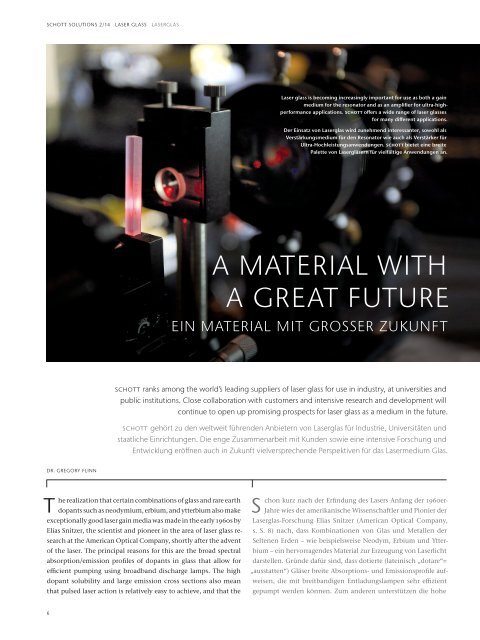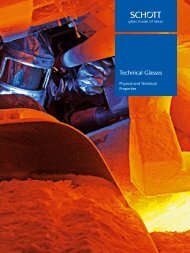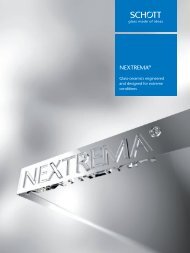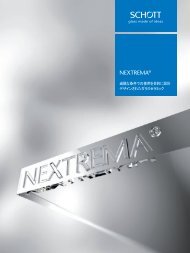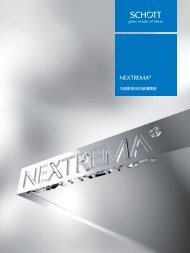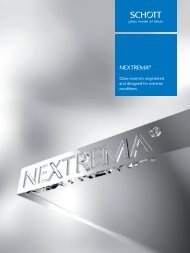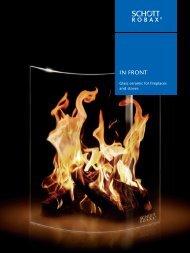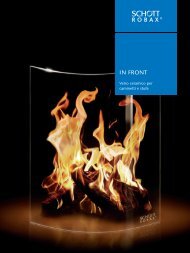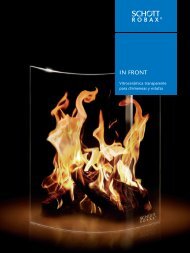Technology Magazine "SCHOTT solutions" Edition 2/2014
The SCHOTT solutions glass magazine features articles, reports and interviews on glass technological challenges from all over the world. The SCHOTT Technology Magazine. Beiträge, Reportagen und Interviews zu Lösungen von SCHOTT für technologische Herausforderungen weltweit.
The SCHOTT solutions glass magazine features articles, reports and interviews on glass technological challenges from all over the world.
The SCHOTT Technology Magazine. Beiträge, Reportagen und Interviews zu Lösungen von SCHOTT für technologische Herausforderungen weltweit.
You also want an ePaper? Increase the reach of your titles
YUMPU automatically turns print PDFs into web optimized ePapers that Google loves.
<strong>SCHOTT</strong> SOLUTIONS 2/14 LASER GLASS LASERGLAS<br />
Laser glass is becoming increasingly important for use as both a gain<br />
medium for the resonator and as an amplifier for ultra-highperformance<br />
applications. schott offers a wide range of laser glasses<br />
for many different applications.<br />
Der Einsatz von Laserglas wird zunehmend interessanter, sowohl als<br />
Verstärkungsmedium für den Resonator wie auch als Verstärker für<br />
Ultra-Hochleistungsanwendungen. schott bietet eine breite<br />
Palette von Lasergläsern für vielfältige Anwendungen an.<br />
A MATERIAL WITH<br />
A GREAT FUTURE<br />
EIN MATERIAL MIT GROSSER ZUKUNFT<br />
schott ranks among the world’s leading suppliers of laser glass for use in industry, at universities and<br />
public institutions. Close collaboration with customers and intensive research and development will<br />
continue to open up promising prospects for laser glass as a medium in the future.<br />
schott gehört zu den weltweit führenden Anbietern von Laserglas für Industrie, Universitäten und<br />
staatliche Einrichtungen. Die enge Zusammenarbeit mit Kunden sowie eine intensive Forschung und<br />
Entwicklung eröffnen auch in Zukunft vielversprechende Perspektiven für das Lasermedium Glas.<br />
DR. GREGORY FLINN<br />
T<br />
he realization that certain combinations of glass and rare earth<br />
dopants such as neodymium, erbium, and ytterbium also make<br />
exceptionally good laser gain media was made in the early 1960s by<br />
Elias Snitzer, the scientist and pioneer in the area of laser glass research<br />
at the American Optical Company, shortly after the advent<br />
of the laser. The principal reasons for this are the broad spectral<br />
absorption/emission profiles of dopants in glass that allow for<br />
efficient pumping using broadband discharge lamps. The high<br />
dopant solubility and large emission cross sections also mean<br />
that pulsed laser action is relatively easy to achieve, and that the<br />
S<br />
chon kurz nach der Erfindung des Lasers Anfang der 1960er-<br />
Jahre wies der amerikanische Wissenschaftler und Pionier der<br />
Laserglas-Forschung Elias Snitzer (American Optical Company,<br />
s. S. 8) nach, dass Kombinationen von Glas und Metallen der<br />
Seltenen Erden – wie beispielsweise Neodym, Erbium und Ytterbium<br />
– ein hervorragendes Material zur Erzeugung von Laserlicht<br />
darstellen. Gründe dafür sind, dass dotierte (lateinisch „dotare“=<br />
„ausstatten“) Gläser breite Absorptions- und Emissionsprofile aufweisen,<br />
die mit breitbandigen Entladungslampen sehr effizient<br />
gepumpt werden können. Zum anderen unterstützen die hohe<br />
6


